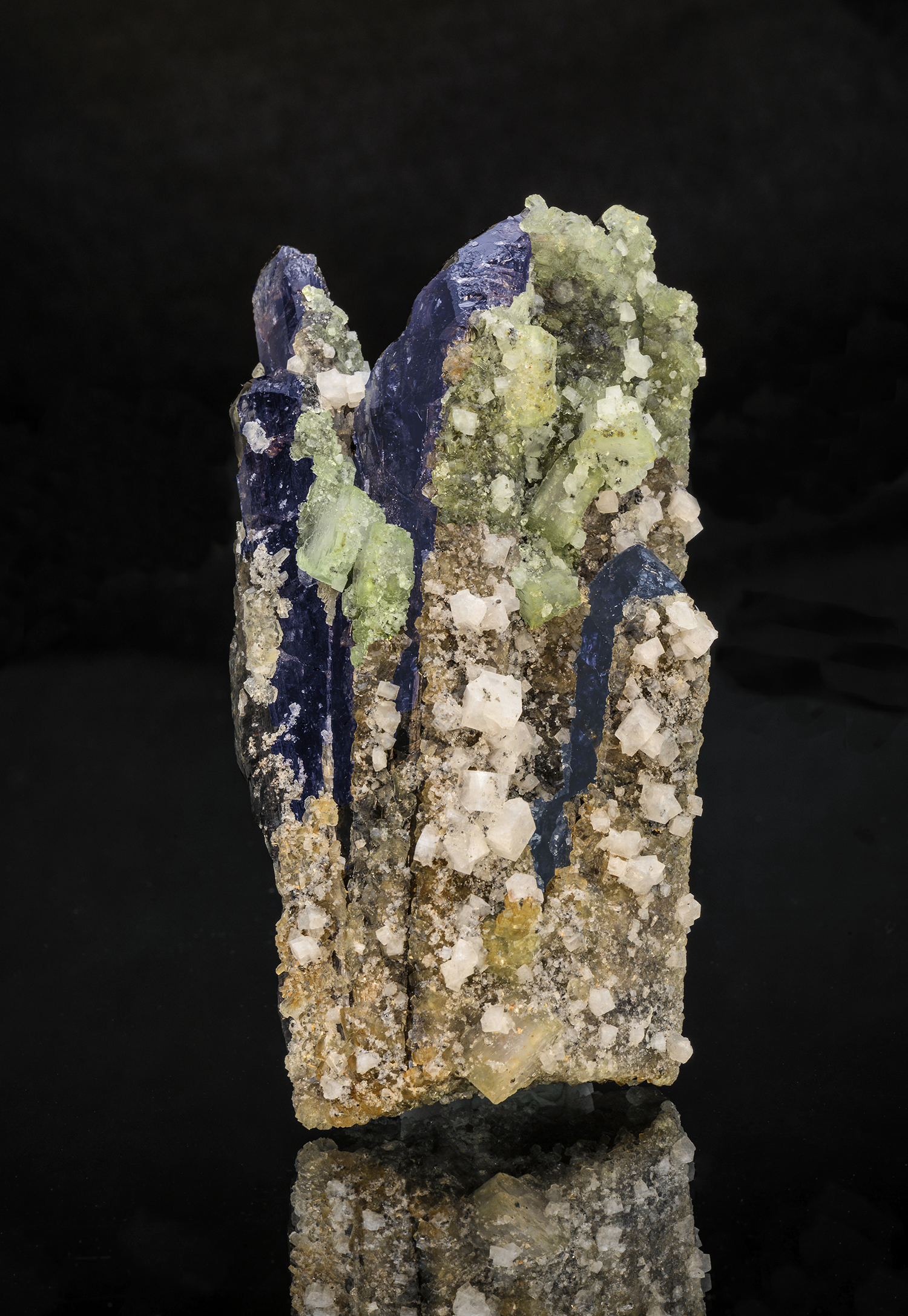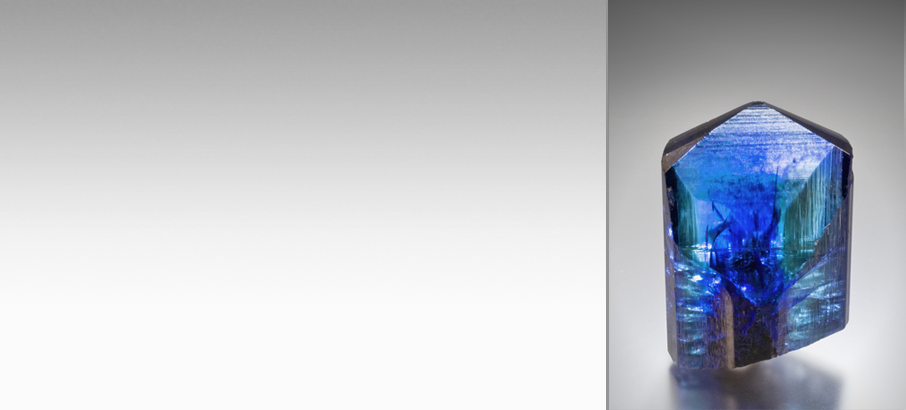Dr. Raquel Alonso-Perez, keynote speaker – The Mozambique Belt – abstract »
The eastern margin of Africa, southern Madagascar, northwestern Pakistan, southern India, Sri Lanka, and eastern Antarctica are considered relics of the Neoproterozoic Metamorphic Mozambique belt (NMMB), the so-called Mozambique gem belt. Along this north-south trending orogenic belt, many varieties of gemstones occurrences are found, including ruby, sapphire, emerald, diamond, tourmaline, spinel, and alexandrite, as well as garnet varieties such as demantoid, color-change garnet, hessonite, and spessartine. However, only two gemstones are unique to this belt: tanzanite and tsavorite. Tanzanite, the blue-violet variety of zoisite, and tsavorite, a green variety of garnet, share a common location, time of discovery – 50 years ago – and most importantly genesis of formation. This talk will present an overview of the chemistry, mineralogy, and geology of formation of tanzanite and tsavorite.
Meg Berry – Creating a World-Class Tanzanite Collection: From Sourcing to Suite-ing – abstract »
This presentation will tell the story of a 10-year quest to build a private collection of the finest tanzanites and unheated zoisites. There will be documentation of sources, details about rough selection, and technical discussions of the cutting process. This will include rough orientation and cutting techniques.
Bruce and Judith Bridges, keynote speakers – 50 Years of Tsavorite and Tanzanite – abstract »
The son and wife of the legendary geologist Campbell Bridges will offer a firsthand account of the history of tsavorite and his adventure-filled life. Renowned for his discovery of tsavorite, Campbell Bridges was also Tiffany & Co.'s consultant geologist on tanzanite and the person who first brought it to the United States for identification. His geological expertise allowed him to lead successful, if often perilous, quests for some of the world's rarest gemstones in the uninhabited bush of East Africa. His buccaneering life featured frequent brushes with snakes and scorpions, big cats and buffalo, and of course, his discovery of tsavorite in the Tanzanian bush, in 1967.
Bruce will also discuss the evolution and development of the famed Scorpion mine and the tsavorite mining industry over the past five decades, up to and including the present-day mining landscape in Kenya. In addition, he will show the company's fully integrated operation, which includes every aspect from mining, sorting, grading and cutting to marketing and sales. For the first time in her storied career Judith Bridges will present and relate never-before-heard experiences working by Campbell Bridges' side.
Robert Gessner – Tanzanite: Geology and Gemology – abstract »
Tanzanite is the blue-violet gemstone variety of the mineral species zoisite, found only in the northeastern part of Tanzania, near the town of Merelani. Discovered in 1967, very little geology work and research was conducted on the deposit until 1998, when Block C began to be mined in a formal and professional manner. This is significant, because Block C consists of the largest and the central 2 km2 section of the known 7 km2 deposit, and also because for the first time there was significant surface and underground rock exposure, outcrop availability, and drill core.
The geological history of the deposit and the formation of tanzanite is complex. This region of the Mozambique Belt dates back to approximately 1000 Ma (million years ago) and has been subjected to multiple phases of high-grade metamorphism and granulite facies conditions (10–12 kbar and 850–1000°C). Crustal uplift resulted in multiphase retograde deformation events and the crucial tanzanite-forming event of the Pan African at ca. 550–500 Ma in amphibolite/greenschist facies conditions (6–7 kbar and 520–600°C).
The complex deformational history and geochemical events played critical roles in the mineralization processes. Calc-silicate skarn layers were created in the stratigraphic sequence through the metamorphism and metasomatism of calcium-rich boudinaged zones and depleted graphitic gneiss horizons. V-rich green grossular garnet crystallized in tension zones during prograde metamorphism.
Tanzanite mineralization occurred during the retrograde period ca. 585 ± 28 Ma at P-T conditions estimated at 5–6 kbar and 650 ± 50°C through two different processes. One was the recrystallization of grossular garnet during the retrograde phase, and the other was migration and crystallization of V and Ca-enriched fluids.
Bill and Will Larson – Collecting Tanzanite and Tsavorite Crystals – abstract »
This presentation will offer the collector's perspective on evaluating and obtaining the finest natural crystals of these two gemstones.
Shane F. McClure – Treatments of Tanzanite and Tsavorite – abstract »
This presentation will discuss the known treatments of tanzanite and tsavorite. There are very few treatments done to tsavorite, but tanzanite has several possibilities. In addition to treatments, we will also discuss the various imitations that have shown up over the years and how you can recognize them.
Nathan Renfro – The Microworld of Tanzanite and Tsavorite – abstract »
In this presentation, a variety of tanzanites and tsavorites and their different inclusion scenes are examined, revealing the unique stories they have to offer.
Stuart Robertson – Tanzanite Price Trends – Past, Present and Future – abstract »
Few gems have achieved the prominence of tanzanite in the international market. During the 1990s and into the early 2000s, tanzanite was one of the most popular gems in the Western market. For a period of time, dealers recognized this status, often referring to ruby, sapphire, emerald, and tanzanite as the Big Four. Unlike the prior three, tanzanite is generally accepted to be limited to a single location—Merelani, Tanzania. As such, tanzanite is far rarer than most gemologists realize. Over the course of five decades, few gems have experienced the price and market volatility of tanzanite. Yet during that timeframe, this gem has traded within a narrow price range, having established a well-defined price floor and ceiling.
This presentation will examine key price influencers for tanzanite observed during various points along the gem's 50-year history. The presentation will conclude with a few comments regarding future demand and price projections for this best-known zoisite variety.
Dr. George Rossman – Additional Remarks on Tanzanite and Tsavorite – abstract »
Tsavorite's color comes from a combination of vanadium and chromium. Vanadium content can commonly range from a few tenths of a percent to about three percent, while chromium concentrations are commonly an order of magnitude lower. However, some garnets from the tsavorite mines have up to five to seven times more chromium than vanadium. Unlike the case for ruby and spinel, which are red due to their chromium content, both vanadium and chromium cause green color in tsavorite garnets.
The variety of zoisite known as tanzanite, when in its natural state, can be a spectacularly pleochroic mineral displaying different colors when viewed down the a-, b-, or c-axis or when viewed in linearly polarized light. Examples of these spectacular colors will be illustrated. Many tanzanite specimens also show a significant color change when heated at several hundred degrees. These colors principally derive from tanzanite's vanadium content. Other colors of zoisite also occur in and around the tanzanite mines, ranging from yellow and golden orange to pink. For example, pink color is associated with low vanadium and elevated manganese concentrations. Spectroscopic and chemical studies help to determine the metal ions responsible for the color and their oxidation states.
* Program subject to change without notice




